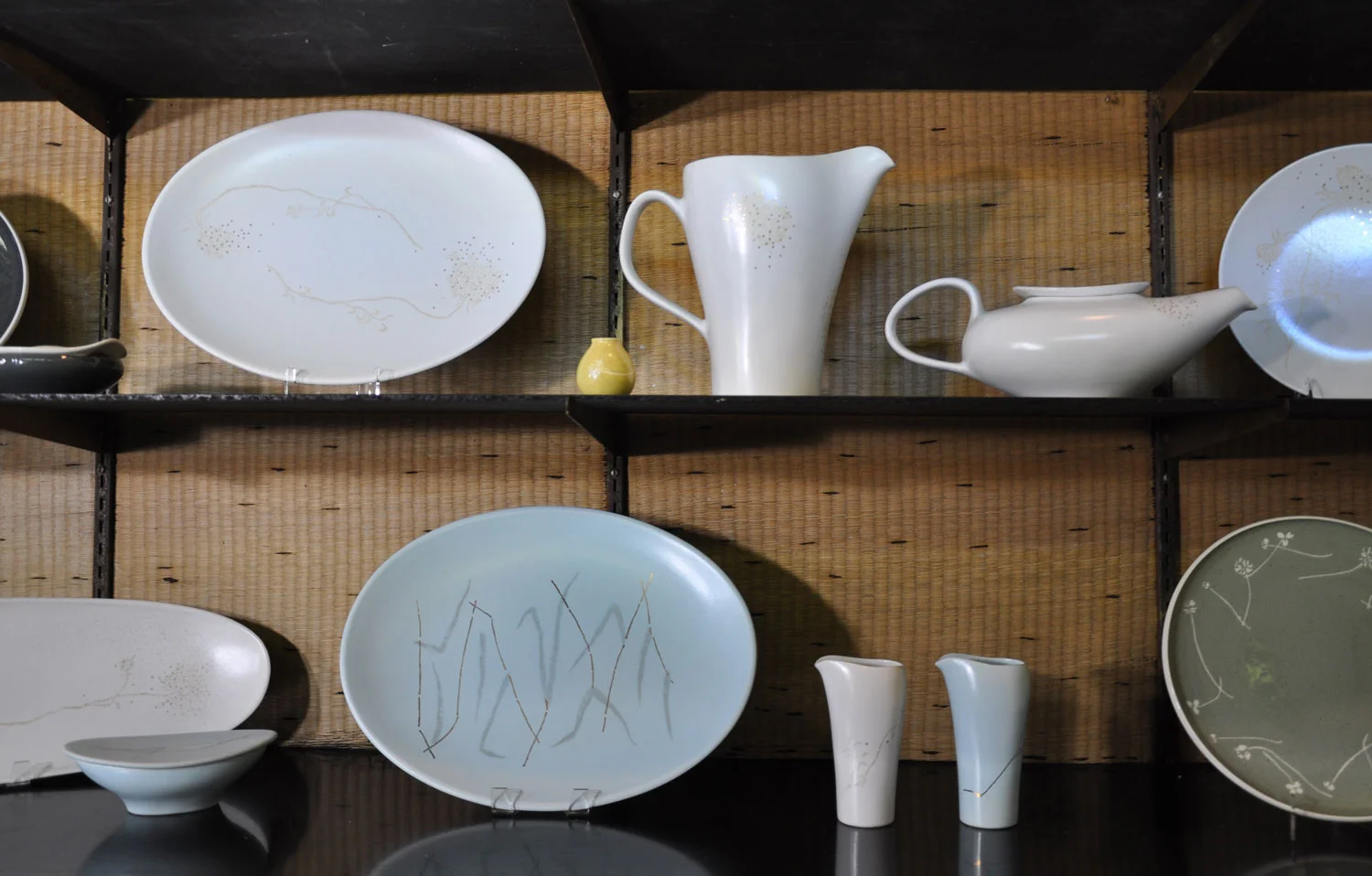2017-2018 Exhibition - Nature in Design
While the beauty of Russel Wright’s early dinnerware lines lay in color and shape, the late lines were distinctive for their ornamentation, often drawn from nature and sometimes literally incorporating it, just as he put hemlock needles into the wet paint on the walls at Manitoga to give them texture. Stems, leaves, and blossoms of white clover grew all over the slopes at Manitoga. They were pressed into ceramic prototypes for the mass production of Harker China Company’s White Clover line, which was launched in 1951, and ultimately served as the everyday dinnerware used at Manitoga. In Wright’s first attempt to apply pattern to dinnerware, the clover design patterns were incised into the dinnerware’s surfaces, which came in four nature-inspired colors: Golden Spice, Meadow Green, Coral Sand, and Charcoal.
Introduced four years after Harker’s White Clover, Wright’s Knowles Esquire line of dinnerware (1955 to 1962) incorporated patterns drawn from sketches Wright made of Queen Anne’s lace, seedpods, and grasses while exploring Manitoga’s landscape. Each of seven patterns was lightly stamped on a matte background.
The culmination of Wright’s attempts to integrate man and nature in his designs, however, came in his 1959 Flair dinnerware line’s Ming Lace pattern—the others were called Spring Garden, Golden Bouquet, and Arabesque—real leaves were embedded in translucent plastic. This strategy was applied as well at Manitoga, where translucent plastic walls were embedded with pressings of local plants and Brazilian butterflies.
Excerpted from Russel Wright: An American Modern, by Donald Albrecht and Dianne Pierce, Co-Curators of Russel Wright: The Nature of Design, August 29, 2012 - March 10, 2013 Samuel Dorsky Museum of Art, SUNY New Paltz.
Exhibition objects from the Collection of Melissa Meyers, promised gifts of Dennis Mykytyn, and the Collection of Manitoga, Inc. through generous collection donations from Charles Burleigh & Lithgow Osborne, Lyn Fischbach, Robert Seal & Michael Pfannenstiel, and Elizabeth Szancer & Tom Zoufaly.
2017-2018 Nature In Design
Russel Wright Dinnerware Inspired by Manitoga
Includes examples from the following lines:
Harker China Company’s White Clover (1951)
Knowles Esquire (1955-1962)
Flair - Ming Lace (1959)
On view with Tour Participation June 2, 2017 - November 12, 2018
While the beauty of Russel Wright’s early dinnerware lines lay in color and shape, the late lines were distinctive for their ornamentation, often drawn from nature and sometimes literally incorporating it, just as he put hemlock needles into the wet paint on the walls at Manitoga to give them texture. Stems, leaves, and blossoms of white clover grew all over the slopes at Manitoga. They were pressed into ceramic prototypes for the mass production of Harker China Company’s White Clover line, which was launched in 1951, and ultimately served as the everyday dinnerware used at Manitoga. In Wright’s first attempt to apply pattern to dinnerware, the clover design patterns were incised into the dinnerware’s surfaces, which came in four nature-inspired colors: Golden Spice, Meadow Green, Coral Sand, and Charcoal.
Introduced four years after Harker’s White Clover, Wright’s Knowles Esquire line of dinnerware (1955 to 1962) incorporated patterns drawn from sketches Wright made of Queen Anne’s lace, seedpods, and grasses while exploring Manitoga’s landscape. Each of seven patterns was lightly stamped on a matte background.
The culmination of Wright’s attempts to integrate man and nature in his designs, however, came in his 1959 Flair dinnerware line’s Ming Lace pattern—the others were called Spring Garden, Golden Bouquet, and Arabesque—real leaves were embedded in translucent plastic. This strategy was applied as well at Manitoga, where translucent plastic walls were embedded with pressings of local plants and Brazilian butterflies.
Excerpted from Russel Wright: An American Modern, by Donald Albrecht and Dianne Pierce, Co-Curators of Russel Wright: The Nature of Design, August 29, 2012 - March 10, 2013 Samuel Dorsky Museum of Art, SUNY New Paltz.
Exhibition objects from the Collection of Melissa Meyers, promised gifts of Dennis Mykytyn, and the Collection of Manitoga, Inc. through generous collection donations from Charles Burleigh & Lithgow Osborne, Lyn Fischbach, Robert Seal & Michael Pfannenstiel, Elizabeth Szancer & Tom Zoufaly, and Nancy Voorhies.
Special thanks to Celia Imrey, Imrey Studio, for display design.
Photos: Nature in Design on display in the Flower Arranging Room at Manitoga, Vivian Linares; Knowles Esquire Platter, Anita Calero; White Clover-Charcoal, Chris Day




